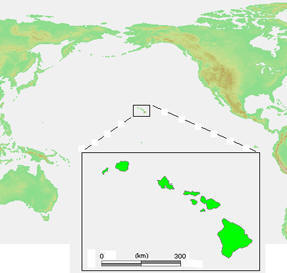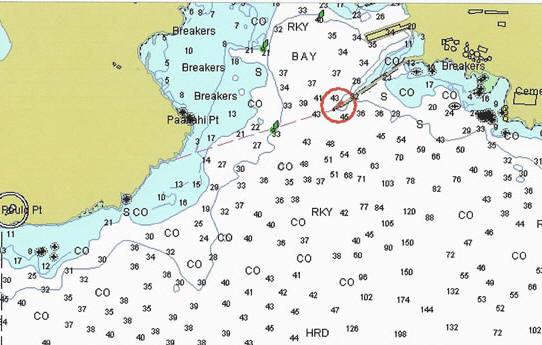Hawaii Is Bigger Than You Think!
Background Sound: Aloha Oe
We visited Hilo , Honolulu , Kauai , Kona Hawaii , and Lahaina on this trip.
 Hawaii (Hawaiian: Hawai'i) became the 50th state of the United States on August 21, 1959. It is situated in the North Pacific Ocean, 2,300 miles (3,700 km) from the mainland, at 21°18′41″N, 157°47′47″W. In the 19th century, Hawaii was also known as the Sandwich Islands.
Hawaii (Hawaiian: Hawai'i) became the 50th state of the United States on August 21, 1959. It is situated in the North Pacific Ocean, 2,300 miles (3,700 km) from the mainland, at 21°18′41″N, 157°47′47″W. In the 19th century, Hawaii was also known as the Sandwich Islands.
An archipelago in the mid-Pacific and, thus, commonly included in Oceania, it is sometimes confused as part of North America however this is incorrect. Hawaii is the southernmost state of the United States; it would be the westernmost, if not for Alaska. It is one of only two states (Alaska is the other) that are outside the contiguous United States, and do not share a border with another U.S. state. Hawaii is the only state that is without territory on the mainland of any continent; is completely surrounded by water; and continues to grow in area because of active extrusive lava flows, most notably from Kilauea (Kīlauea).
Hawaii Is 1,500 Miles In Length (Click The Map To Enlarge)
Except for Easter Island, Hawaii is farther away from land than any other landmass on Earth. Hawaii's tallest mountain, Mauna Kea stands over 13,000 feet (4,000 meters) and is taller than Mount Everest if followed to its base at the floor of the Pacific Ocean.
The Hawaiian Archipelago comprises eight islands and atolls extending across a distance of 1,500 miles (2,400 km). Of these, eight high islands are considered the "main islands" and are located at the southeastern end of the archipelago. These islands are, in order from the northwest to southeast, Ni'ihau, Kaua'i, O'ahu, Moloka'i, Lāna'i, Kaho'olawe, Maui, and Hawai'i. The latter is by far the largest, and is very often called the "Big Island" or "Big Isle". The use of that alternative name is often motivated by a desire to avoid ambiguity with "Hawaii" meaning the entire state (all of the islands), as opposed to only that one island.
As Seen From Space Shuttle 1988
 Explanation: With the graceful arc of Earth's limb in the background, the Hawaiian Island archipelago is visible in this stunning photo taken by the astronauts onboard the space shuttle Discovery in October of 1988.
Explanation: With the graceful arc of Earth's limb in the background, the Hawaiian Island archipelago is visible in this stunning photo taken by the astronauts onboard the space shuttle Discovery in October of 1988.
Along with popular beaches and tropical resorts, these volcanic islands offer extreme elevations with dark, dry, cloudless skies.
Consequently, they have also become popular sites for large and sophisticated ground-based telescopes
Port Allen Warning
 Until further notice, the main pier at Port Allen no longer in use by large, deep draft vessels. The south face of the pier is used primarily by small commercial tour boats. There is little shelter for vessels intending to anchor off Port Allen. In order for a vessel to get in the lee of the bluffs located on the eastern shoreline, a vessel would be positioned dangerously close to shallow water near the breakwater. Fresh trade winds generally make this area a poor anchorage. The harbor is congested with small commercial charter boats. There is little swinging room within the basin. Port Allen is known for surge conditions. At times the surge is severe enough to discourage commercial vessels from mooring at the south face of the main pier
Until further notice, the main pier at Port Allen no longer in use by large, deep draft vessels. The south face of the pier is used primarily by small commercial tour boats. There is little shelter for vessels intending to anchor off Port Allen. In order for a vessel to get in the lee of the bluffs located on the eastern shoreline, a vessel would be positioned dangerously close to shallow water near the breakwater. Fresh trade winds generally make this area a poor anchorage. The harbor is congested with small commercial charter boats. There is little swinging room within the basin. Port Allen is known for surge conditions. At times the surge is severe enough to discourage commercial vessels from mooring at the south face of the main pier
